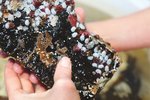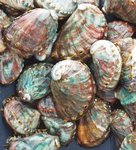Ali Redman’s hands are as much at home in salt water as the endangered abalone she’s helping to rear in captivity.
As she bent over a tank of juvenile pinto abalone …
This item is available in full to subscribers.
We have recently launched a new and improved website. To continue reading, you will need to either log into your subscriber account, or purchase a new subscription.
If you had an active account on our previous website, then you have an account here. Simply reset your password to regain access to your account.
If you did not have an account on our previous website, but are a current print subscriber, click here to set up your website account.
Otherwise, click here to view your options for subscribing.
* Having trouble? Call our circulation department at 360-385-2900, or email our support.
Please log in to continue |
|


Ali Redman’s hands are as much at home in salt water as the endangered abalone she’s helping to rear in captivity.
As she bent over a tank of juvenile pinto abalone at the Port Townsend Marine Science Center, she trailed a small piece of kelp through the water, temping the tiny marine snails with the freshly torn edge.
Careful focus — most of the shells were less than 1/4-inch-long — revealed enthusiastic appeal for the slice of bull kelp. Several tiny creatures scooted toward the green strand, their epipodium, or hair-width food-sensing tentacles, on their single muscular foot, waving.
“They have little faces,” she said, engrossed.
The abalone left little white squiggles on the sediment at the bottom of their shallow tank, their almost-invisible stalked eyes bobbing.
However minute these Haliotis kamtschatkana are, they are a big deal.
This September, the Washington Department of Fish and Wildlife drafted the first-ever recovery plan for the only abalone found in Washington. Two years ago, the pinto abalone, sometimes called the northern abalone, was added to the Washington state endangered species list. Without a supplementation program to augment the dwindling wild population, the species will likely face extirpation, a fancier way of saying extinction.
To date, only one pinto abalone, a juvenile, has been observed by research divers in Washington since 2008.
Redman has worked at the Marine Science Center based at Fort Worden for five years. She earned a degree in marine conservation and science from the Scripps Institution of Oceanography at the University of California San Diego before heading back to her home state and landing a job in Port Townsend.
The pinto abalone satellite project (currently at just two locations, the science center and the Seattle Aquarium), is critical to the success of an abalone outplanting program, where 1- to 2-year-old abalone who have been raised in captivity are released into the wild.
Overfishing for the delectable meat and beautiful shells is blamed for the disappearance of the now-rare abalone, as well as two major ecological events. Sea stars died in droves between 2014 and 2015 when a wasting disease hit hard. Coupled with unusually warm water from an El Niño, which killed off massive colonies of bull kelp, an imbalance occurred. Purple sea urchins, whose main predator is the sea star and who compete with the abalone for kelp, soon created urchin barrens, effectively over-grazing the sea algae and reducing abalone habitat.
According to the state’s recovery plan, bull kelp populations have been declining along the West Coast in the past decade, and it further states: “It is imperative to acknowledge that pinto abalone recovery is dependent on the survival of kelp forests.”
Redman explained why this is important.
“They’re habitat architects,” she said. “Because they’re going around, grazing on algae, they are helping maintain a rocky reef balance.”
These aggregate, mostly sedentary creatures are also dioecious spawners, which means that with both sexes broadcasting sperm or eggs, there is a need for a certain population density and proximity in order to be viable. The baby pintos begin as larvae feeding off of the eggs’ yolks, before looking for settling cues that a certain biofilm on a crustose coralline emits. Once attached, they begin the metamorphosis into a crawling juvenile.
The three shallow tanks of pinto abalone Redman looks after are in this juvenile stage.
The center’s location right on the water allows for an open flow-through water circulation system, cycling water through the tanks from the bay below.
The Puget Sound Restoration Fund, which has worked with Fish and Wildlife since 2002 to troubleshoot saving the pinto abalone, delivered 1,500 captive-bred tiny abalone to the Marine Science Center in May, at the delicate age of 9 months old.
“It’s our biggest batch yet,” Redman said.
Staff measure a subset from each tank, which contain genetically separate batches, monthly to track growth.
“Genetic diversity is really important to the restoration process,” she said, adding that all of the little juveniles are referred as “F-1s,” the offspring of two wild-caught adults.
When they are large enough, a brightly colored marker dot (the same used to track bees) is adhered with what Redman called “coral glue,” a super glue used in coral restoration.
She picked up a pinto abalone shell from a nearby shelf, showing the tell-tale pinto color splotches on the back, pointing to a small, ½-inch-long rectangle embedded in the outer shell. Just like the rest of the shell’s interior, the little rectangle was coated in iridescent nacre, commonly known as mother of pearl.
That rectangle, she said, was a PIT, or a passive integrated transponder, a micro-chip that would allow divers to account for individuals in areas where visibility was limited.
The 18-month-old abalone will return to the restoration fund next March, and a new cohort will be welcomed. Redman said there are plans for expanding the capacity of the satellite program, as the results from the past two years have been encouraging.
Since 2009, around 40,000 genetically diverse pinto abalone have been released in 21 secret sites in the San Juan Islands. While the news is encouraging, the cost of breeding and raising a cohort of pinto abalone runs about $12,000 a month, according to state research. Larvae release is being studied as a most cost-effective method, but for now, scientists are sticking to the tried and true.
Ultimately, it’s education and awareness that will have to sync in order to save the pinto abalone.
The recovery plan document is frank, stating that the Fish and Wildlife Department and its partners “do not have the financial or staff resources to undertake all facets of the expanding recovery effort.”
The department welcomes public comments on the plan at publicinput.com/PintoAbalone.
Learn more about volunteering for the Port Townsend Marine Science at ptmsc.org.